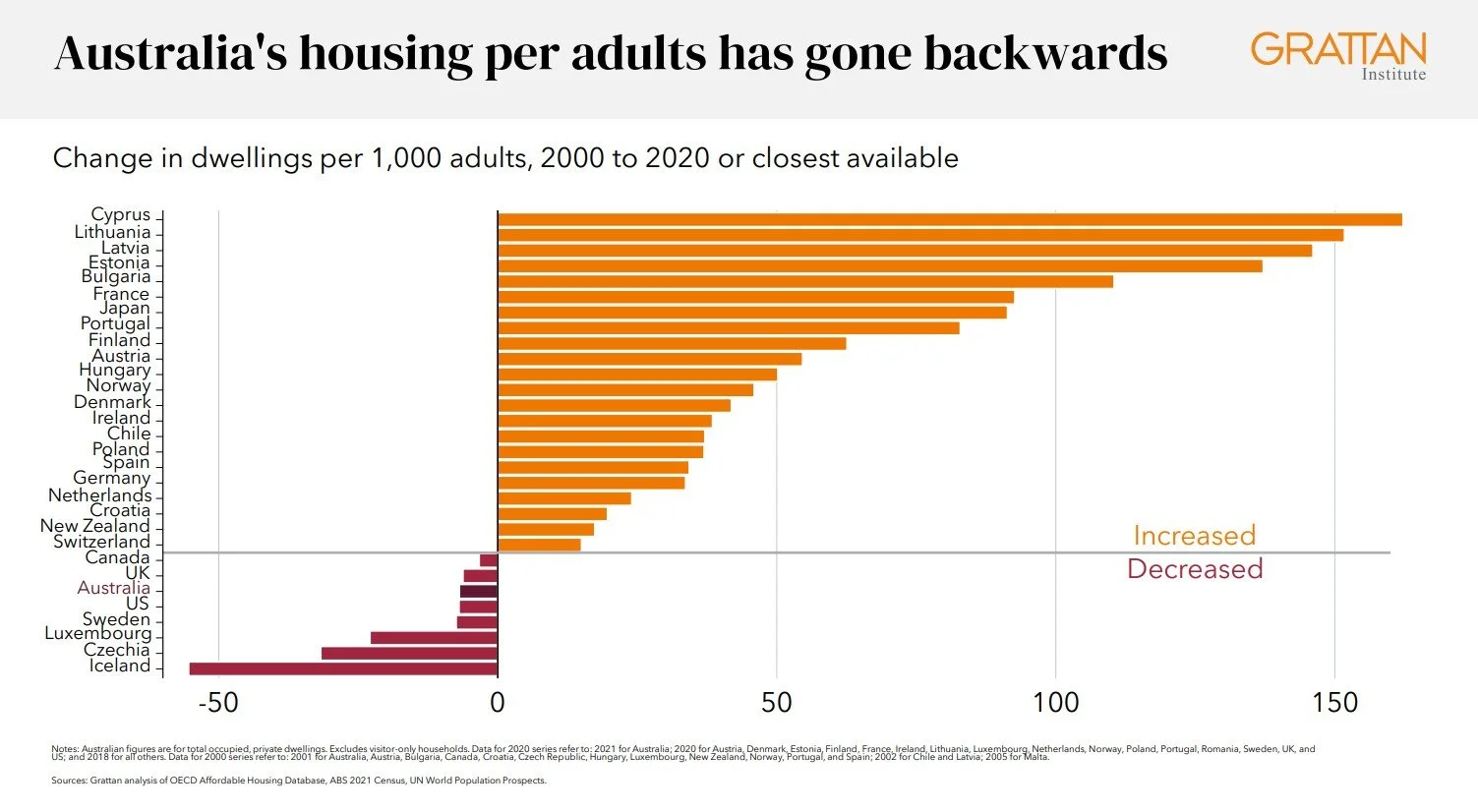by Brendan Coates, Joey Moloney, Matthew Bowes, The Grattan Institute
Three-storey townhouses and apartments should be permitted on all residential land in all capital cities as part of a concerted policy assault on Australia’s housing crisis.
Housing developments of six storeys or more should be allowed as-of-right around major transit hubs and key commercial centres.
Housing in Australia’s major cities is among the least affordable in the world.
Restrictive planning controls add hundreds of thousands of dollars to the cost of new housing in our capital cities.
For decades, Australia has failed to build enough homes in the places that people most want to live.
Now we have a housing affordability crisis that is dividing families and communities and robbing young Australians of their best chance in life.
The key problem is that state and territory land-use planning systems say ‘no’ to new housing by default, and ‘yes’ only by exception.
About 80 per cent of all residential land within 30km of the centre of Sydney, and 87 per cent in Melbourne, is zoned for housing of three storeys or fewer. And three quarters or more of residential land in Brisbane, Perth, and Adelaide is zoned for two storeys or fewer.
The upshot is that our capital cities are among the least dense of their size in the world.
Allowing more housing in established suburbs would mean cheaper housing in all suburbs.
It would boost Australians’ incomes and quality of life, by letting more people live closer to high-paying jobs as well as transport, schools, and other amenities.
And it would mean shorter daily commutes and hence lower greenhouse-gas emissions.
Developments of up to three storeys that meet clear standards should not need a planning permit.
Larger developments that meet pre-set criteria should be assessed via ‘deemed-to-comply’ approval pathways.
Allowing three-storey townhouses and apartments on all residential land in capital cities would unlock commercially feasible capacity for more than one million new homes in Sydney alone.
Our modelling for this report shows that these reforms could lift housing construction across Australia by up to 67,000 homes a year, which over a decade could cut rents by 12 per cent and slice more than $100,000 off the cost of the median-priced home, and by much more in the longer term.
Australia needs a housing policy revolution. The equation is simple: If we build more homes where people most want to live, housing will be cheaper and our cities will be wealthier, healthier, and more vibrant.
Australia has built too few homes where Australians most want to live
• Australia’s housing stock per adult has gone backwards, whereas housing demand has risen rapidly
• Australia’s capital cities are among some of the least dense of their size in the world
Restrictive planning systems prevent many more homes from being built
• Land-use planning is necessary to mediate between land uses and coordinate the public realm. But there are three problems:
1. Much inner-city land in our major cities is subject to restrictive zoning & built form controls that prevent greater density
2. Development approval processes are costly, slow, and uncertain
3. The governance of planning systems favours existing residents and is biased against change
States should reform their planning systems to permit more housing
• Upzone their capital cities, particularly in high-demand areas:
- A Low-Rise Housing Standard: three-storey townhouses should be permitted on all residential-zoned land in capital cities
- A Mid-Rise Housing Standard: allow for 6+ storeys around transit hubs, and higher densities where there is unmet demand
• Modest density should use complying development pathways & higher density should mostly be deemed-to-comply
• Improve evaluation and review: subject planning controls to cost-benefit analyses and regularly evaluate feasible capacity
Recent planning reforms in NSW and Victoria don’t go far enough
• Victoria’s planning reforms are more ambitious than those in NSW, especially in allowing modest density via the Townhouse Code
• Both states’ have upzoned for higher density around transit hubs, but higher density is more feasible in Sydney currently
The federal government should sharpen incentives to encourage states to get more housing built
• The New Home Bonus isn’t working: most states are not on track to qualify for incentive payments
• The federal govt. should pay the states for specific residential planning reforms in a revitalised National Competition Policy
• The Productivity Commission should regularly assess the performance of planning systems, including feasible capacity
This article is republished from The Grattan Institute under Creative Commons license. Read it here.



